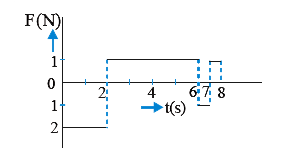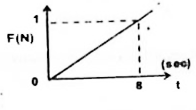Statement A : If the force varies with time in a complicated way then the average force is measured by the total change in momentum of the body
Statement B : Change in momentum and impulsive force are numerically equal
A and B are correct
A and B are false
A is true and B is false
A is false and B is true
The correct Answer is:C
To analyze the statements provided in the question, we will break down the concepts of force, momentum, and impulse step by step.
Step 1: Understanding Statement A
Statement A claims that if the force varies with time in a complicated way, then the average force is measured by the total change in momentum of the body.
1. Force and Momentum Relation:
- The force (F) acting on an object is related to its momentum (p) by the equation:
F=dpdt
- Here, dp is the change in momentum and dt is the change in time.
2. Average Force:
- The average force over a time interval can be expressed as:
Favg=ΔpΔt
- Where Δp is the total change in momentum over the time interval Δt.
3. Conclusion for Statement A:
- While the average force is related to the total change in momentum, it is important to note that it also depends on the time interval. Therefore, Statement A is incorrect as it does not mention the time factor.
Step 2: Understanding Statement B
Statement B states that the change in momentum and impulsive force are numerically equal.
1. Impulse:
- Impulse (J) is defined as the product of force and the time duration over which the force acts:
J=F⋅Δt
2. Change in Momentum:
- According to the impulse-momentum theorem, the impulse experienced by an object is equal to the change in momentum of that object:
J=Δp
- This means that the impulse applied to an object results in a change in its momentum.
3. Conclusion for Statement B:
- Since impulse is equal to the change in momentum, Statement B is correct.
Final Conclusion
- Statement A is false because it does not account for the time factor in defining average force.
- Statement B is true because it correctly states that change in momentum is equal to the impulse applied.
Answer
- Statement A: False
- Statement B: True
Statement A claims that if the force varies with time in a complicated way, then the average force is measured by the total change in momentum of the body.
- The force (F) acting on an object is related to its momentum (p) by the equation:
F=dpdt
- Here, dp is the change in momentum and dt is the change in time.
- The average force over a time interval can be expressed as:
Favg=ΔpΔt
- Where Δp is the total change in momentum over the time interval Δt.
- While the average force is related to the total change in momentum, it is important to note that it also depends on the time interval. Therefore, Statement A is incorrect as it does not mention the time factor.
Statement B states that the change in momentum and impulsive force are numerically equal.
- Impulse (J) is defined as the product of force and the time duration over which the force acts:
J=F⋅Δt
- According to the impulse-momentum theorem, the impulse experienced by an object is equal to the change in momentum of that object:
J=Δp
- This means that the impulse applied to an object results in a change in its momentum.
- Since impulse is equal to the change in momentum, Statement B is correct.
- Statement A is false because it does not account for the time factor in defining average force.
- Statement B is true because it correctly states that change in momentum is equal to the impulse applied.
- Statement A: False
- Statement B: True
Similar Questions
Knowledge Check
A force of 50 N acts on a body for 10 s. What will be the change in momentum of the body ?
A200 N.sB400 N.sC500 N.sD1000 N.s
The work done by the external forces on a system equals the change in
View SolutionThe average force necessary to stop a hammer with momentum p (in N-s) in 0.5 s is :-
View SolutionA force-time graph for the motion of a body is shown in fig. Change in linear momentum between 0 and 8s is :

View SolutionA force lime graph for the motion of a body is as shown in figure. Change in linear momentum between 0 and 6s is:

View SolutionA force-time graph for the motion of a body is shown in fig. change in linear momentum between 0 and 8 s is:-

View SolutionA force-time graph for the motion of a body is shown in figure. Change in linear momentum between 0 and 8 s is:

View SolutionA force of 10 N acts on a body of mass 2 kg for 3s , initially at rest. Calculate change in momentum of the body.
View Solution
